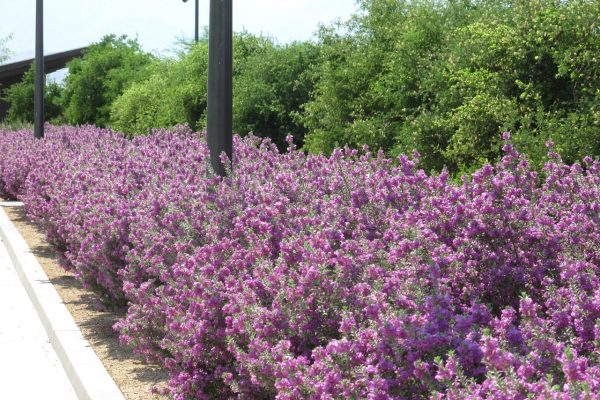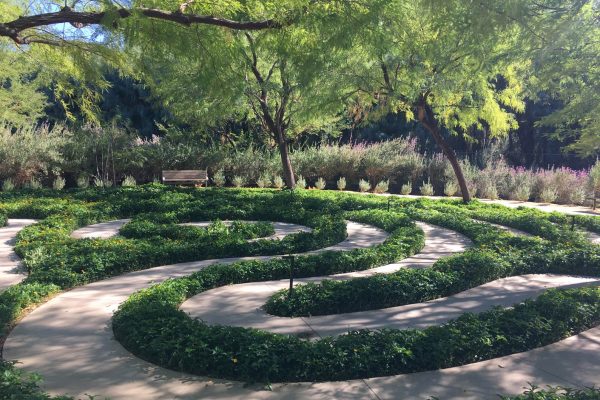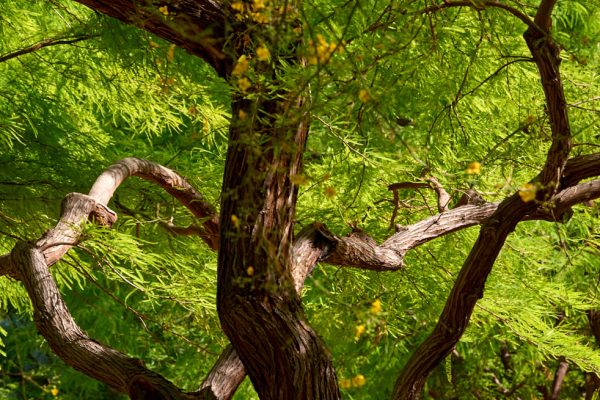
Leucophyllum is the genus for a group of hardy desert shrubs. Most people know it from the common name Texas Ranger or Texas Sage, though it is not a Salvia. Years of commercial cultivation has created a variety of sizes and colors that guarantee a visual variation for almost every desert garden. It blooms in ranges of deep purple to violet and periwinkle, and its fuzzy leaves range from green to silver-gray. Even its size can vary from large shrubs, reaching 6 feet, to smaller compact shrubs.
Sunnylands initially installed six specimens of Leucophyllum spp., but over the years, there have been a few species that triumphed in the gardens. They were the most pest resistant and stood out in color and form. We have reduced the original six to three highlighted species. They are distributed throughout the gardens and can be identified by leaf and/or bloom. The three are, by common name: Green Cloud, Heavenly Cloud, and Sierra Bouquet. They are grouped together here under their genus Leucophyllum, so that their visual features are easy to compare when standing in the gardens.
GREEN CLOUD (Leucophyllum frutescens ‘Green Cloud’)
Green foliage with purple flowers
HEAVENLY CLOUD (Leucophyllum x. ‘Heavenly Cloud’)
Green foliage with bright purple flowers
SIERRA BOUQUET (Leucophyllum pruinosum ‘Sierra Bouquet’)
Gray foliage with periwinkle flowers
Wedelia is the low groundcover that trails around the labyrinth. Its low-spreading nature and deep, glossy green leaves are highlighted by small stems with bright yellow daisy-like flowers.
This is reminiscent of the Angelita Daisy that was the original plant in the labyrinth. It did not do well, and neither did the Trailing Indigo Bush that followed.
The Wedelia seems to be thriving in that space. This exemplifies the multiple micro-climates that can occur in an arid space where differing levels of shade and other ecological challenges can mean the difference between a plant thriving in one spot and declining in another.
Native to Mexico, Central America, and the Caribbean, it is invasive in the neo-tropics.

The gardens are filled with a variety of thorn-less hybrid mesquites. In fact, other than the four Sweet Acacia trees that frame the motor circle in front of the Center, mesquites are the only brown-barked trees in the garden. Their bark colors range from a gray-brown to a deep red-brown and they display a variety of smooth and rough textures.
Mesquites grow naturally as multi-branching trees, which allows them to bend with the strong desert winds. In most of the garden, you will see this multi-trunk growth pattern, but for accessibility in the parking lot and along some paths, they are trained to grow in a single-trunk standard. Whenever possible, natural growth patterns should be encouraged.
As a tribute to Leonore Annenberg, all the trees selected for the Center & Gardens have yellow blooms, one of her favorite colors, and the mesquites are no exception. In the spring, they form dense groupings of yellow tubular flower clusters.
Like many native desert trees, mesquites are legumes, which nourish the desert floor by dropping nitrogen-rich leaves, seedpods, and branches. These fertile grounds offer opportunities for young, fragile plants to get an easier start, but it also means that they require more cleanup.
Their sweet seedpods have been a food staple for humans and native wildlife alike.


